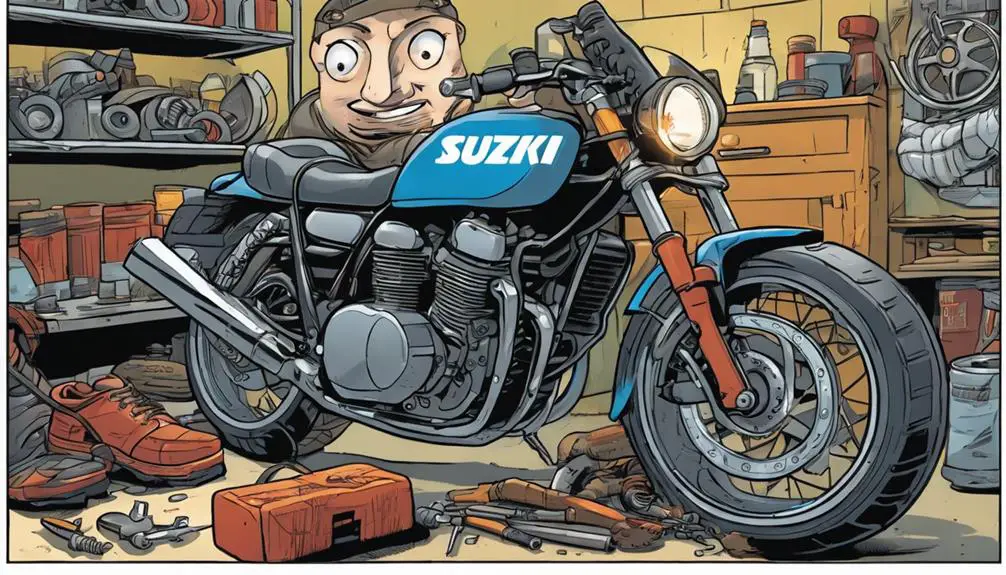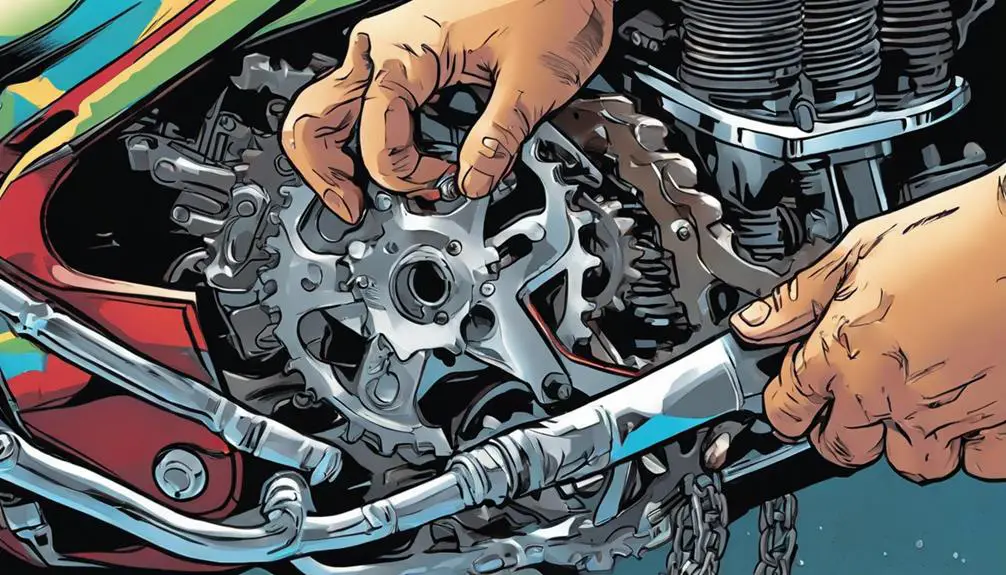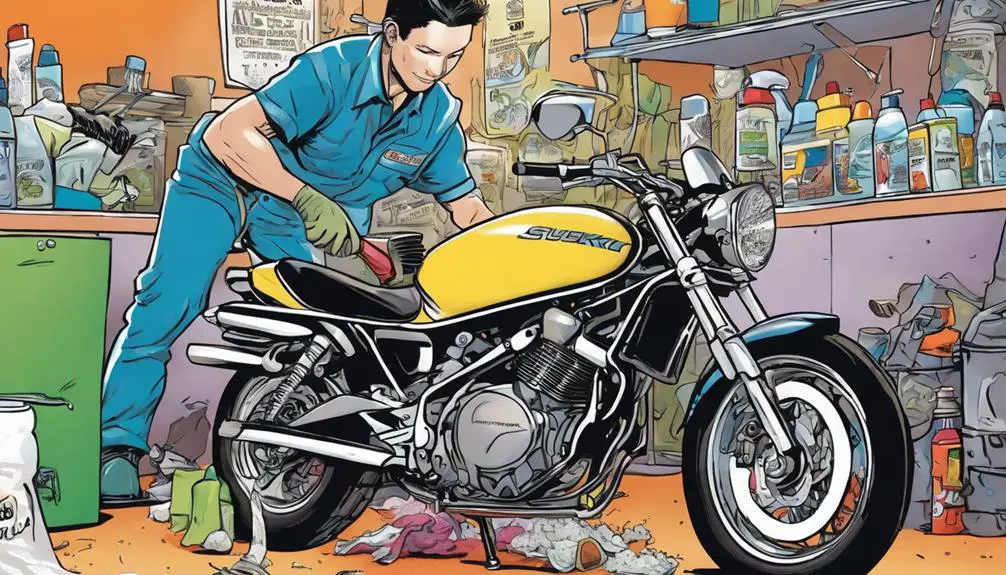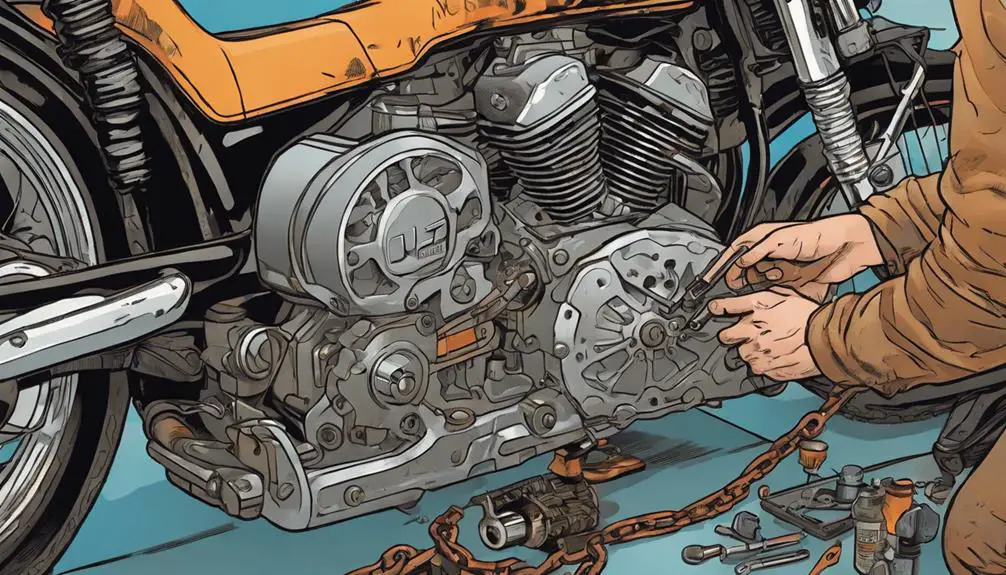Imagine you're gearing up for a long ride on your Suzuki, but a minor oversight leads to unexpected engine trouble halfway through your journey. To avoid such scenarios, it's vital to prioritize maintenance. Regular oil changes, tire inspections, and brake checks can make a significant difference in your bike's performance and safety. Yet, these tips are just the beginning. What other important maintenance practices should you incorporate to keep your Suzuki in top shape?
Quick Takeaways
- Perform regular oil changes every 3,000 to 5,000 miles to maintain engine health and prevent overheating.
- Check tire pressure monthly and inspect tread wear to ensure optimal handling and safety.
- Inspect brake pads and fluid levels frequently; replace pads if they are less than 1/8 inch thick.
- Regularly clean and lubricate the chain, and check for proper wear and tension to ensure smooth operation.
Understanding Suzuki Motorcycle Models

When you immerse yourself in the world of Suzuki motorcycles, you'll find a diverse range of models tailored to different riding styles and preferences.
Whether you crave the thrill of speed, the comfort of long rides, or the versatility of off-road adventures, Suzuki has something for you. The GSX series, for instance, is perfect for those who want high performance and agility on the road. If you're into cruising, the Boulevard lineup offers a laid-back experience with powerful engines and classic styling.
For the adventurous spirit, the V-Strom series combines touring comfort with off-road capabilities, letting you explore beyond the pavement. Meanwhile, the lightweight and nimble Suzuki SV650 is great for those new to motorcycling or anyone looking for an exhilarating ride without the bulk.
Each model is designed to empower you, offering a unique experience that resonates with your sense of freedom. As you choose your Suzuki, consider how each bike aligns with your riding goals and lifestyle.
Understanding these models isn't just about specs; it's about connecting with a motorcycle that embodies your spirit of liberation and adventure.
Regular Oil Change Schedule
Keeping up with your oil change schedule is essential for your Suzuki bike's performance.
High-quality oil not only protects your engine but also enhances its longevity.
Make sure you know the recommended change intervals to keep your ride smooth and reliable.
Importance of Oil Quality
Regularly changing your oil is essential for maintaining the performance and longevity of your Suzuki bike. Fresh, high-quality oil lubricates your engine, reduces friction, and helps regulate temperature, allowing your bike to run smoothly and efficiently.
When you neglect this vital step, you risk overheating and damaging engine components, which can lead to costly repairs and lost freedom on the road.
Choosing the right oil is just as important as changing it regularly. Not all oils are created equal; quality matters. Opt for synthetic oils designed for high-performance engines, as they provide better protection against wear and tear.
These oils also maintain their viscosity over a wider temperature range, ensuring your engine stays lubricated in various conditions.
Moreover, using quality oil helps keep your engine clean by preventing sludge build-up. A clean engine not only performs better but also extends the life of your bike, giving you the freedom to ride longer and explore further.
Recommended Change Intervals
Establishing a consistent oil change schedule is essential for ensuring your Suzuki bike operates at its best and stays reliable on every ride. Regular oil changes help keep your engine clean and functioning smoothly, allowing you the freedom to explore the open road without worry.
Generally, you should change your oil every 3,000 to 5,000 miles, depending on your bike model and riding conditions. If you often ride in extreme temperatures, heavy traffic, or on rough terrain, consider changing it more frequently. Always consult your owner's manual for specific recommendations tailored to your Suzuki.
Don't forget to check your oil level regularly, too. If it's low or dirty, a quick change can prevent serious engine issues down the line.
Tire Maintenance and Inspection

Keeping an eye on your tire maintenance is essential for a safe ride.
You'll want to regularly check your tire pressure and assess tread wear to guarantee peak performance.
Let's break down how these simple steps can make a big difference.
Tire Pressure Checks
Checking your Suzuki bike's tire pressure is essential for ideal performance and safety on the road. When your tires are at the correct pressure, you'll experience better handling, improved fuel efficiency, and a smoother ride. Plus, it can prevent premature tire wear, saving you money in the long run.
Make it a habit to check your tire pressure at least once a month and always before long rides. You'll need a reliable tire pressure gauge for this task. After measuring, compare your readings to the manufacturer's recommended pressure, usually found on a sticker near the bike's frame or in the owner's manual.
If the pressure is low, inflate the tires to the recommended level. If it's too high, release some air until it's just right. Remember, temperature changes can affect tire pressure, so consider checking when temperatures fluctuate.
Don't overlook the importance of proper tire pressure—it's a simple yet powerful step toward ensuring your freedom on the open road.
Tread Wear Assessment
Regularly evaluating your tire tread wear is essential for maintaining ideal grip and safety while riding your Suzuki bike. Ignoring your tire condition can lead to dangerous rides, but with a little attention, you can guarantee a smooth journey.
Here's what you should focus on:
- Tread Depth: Use a tread depth gauge or the penny test to measure how much tread is left.
- Uneven Wear: Check for signs of uneven wear which could indicate alignment or suspension issues.
- Cracks and Bulges: Inspect for any visible damage like cracks or bulges that could compromise your tire's integrity.
- Foreign Objects: Remove any stones or debris lodged in the tread that could cause punctures.
Brake System Care
To guarantee your Suzuki bike's brake system performs at its best, inspect the brake pads and fluid levels frequently.
Start by checking the brake pads for wear. If they're less than 1/8 inch thick, it's time to replace them. Worn pads can compromise your stopping power, putting you at risk on the open road.
Next, examine the brake fluid levels. Low fluid can indicate a leak or worn components. Make sure the fluid is clean and at the recommended level; dirty fluid can hinder performance. If it looks murky, flush the system and replace it with fresh fluid.
Don't forget to inspect the brake lines. Look for any signs of wear, cracking, or leaks. Any damage here can lead to brake failure, so addressing issues early is essential for your safety.
Chain and Sprocket Maintenance

Maintaining your chain and sprocket is essential for guaranteeing smooth performance and prolonging the life of your Suzuki bike. A well-maintained chain reduces friction, enhances acceleration, and gives you the freedom to cruise without worry.
Here are some tips to keep your chain and sprocket in top shape:
- Regularly clean the chain to remove dirt and debris.
- Lubricate the chain after cleaning to minimize wear.
- Check for wear and tension to guarantee it works effectively.
- Inspect sprockets for damage and replace them if they show signs of wear.
Battery Health Checks
After verifying your chain and sprocket are in excellent condition, it's time to focus on battery health checks to keep your Suzuki bike running smoothly.
Start by checking the battery terminals for corrosion. Clean any buildup with a wire brush and a solution of baking soda and water. This'll guarantee a solid connection so your bike can roar to life when you need it.
Next, inspect the battery's fluid levels. If it's a conventional battery, make sure the electrolyte covers the plates. If it's low, top it up with distilled water. Avoid overfilling, as that can lead to spills.
Also, test the battery's voltage with a multimeter. A reading of 12.6 volts or higher indicates a healthy battery. If it's below 12.4 volts, consider charging it, and if it drops further, it might be time for a replacement.
Lastly, remember to check the age of your battery. Most batteries last around three to five years. If yours is nearing the end of its life, don't hesitate to invest in a new one; it's worth it for the freedom of the ride.
Cleaning and Detailing Techniques

Keeping your Suzuki bike looking sharp requires regular cleaning and detailing to protect its finish and enhance your riding experience.
When you take the time to maintain your ride, you not only elevate its appearance but also your connection to the freedom it represents.
Here are some essential techniques to take into account:
- Use a gentle soap designed for motorcycles to avoid damaging the finish.
- Invest in a quality microfiber cloth for drying and polishing.
- Apply a protective wax every few months to shield against the elements.
- Clean your chain regularly and lubricate it to guarantee smooth rides.
Seasonal Maintenance Considerations
Regular cleaning and detailing not only enhances your bike's appearance but also sets the stage for effective seasonal maintenance that can keep your Suzuki running smoothly year-round.
As the seasons change, your bike faces different challenges. In spring, check for any winter-related wear and tear. Inspect the tires for cracks and verify they're properly inflated.
Summer brings heat; keep an eye on the coolant levels and clean the air filter to prevent overheating. If you're hitting the open road, make sure your chain is well-lubricated and tensioned.
When fall arrives, it's time to prepare for the cold. Change the oil and inspect the battery—cold weather can sap its strength, so consider a battery tender.
During winter, store your bike properly. Keep it clean, cover it, and consider using a fuel stabilizer to prevent fuel degradation. Don't forget to periodically start your Suzuki to keep the battery charged and the fluids circulating.
Common Problems and Solutions

Suzuki bikes can encounter a variety of common problems, but knowing how to address these issues can keep your ride smooth and enjoyable. Here's a quick rundown of some frequent challenges and their solutions:
Electrical Issues: Check your battery terminals for corrosion and verify connections are tight. If the lights flicker, consider a new battery.
Oil Leaks: Regularly inspect for oil spots under your bike. Tighten loose bolts and replace worn gaskets to prevent leaks.
Overheating: Keep an eye on your coolant levels. Flush the cooling system periodically, and verify your radiator's free of debris.
Chain Wear: A stretched or rusted chain can affect performance. Clean, lubricate, and adjust the chain tension regularly.
Punctured Tires: Inspect your tires for damage. Carry a repair kit for quick fixes on the road, and consider replacing tires showing significant wear.
Common Questions
How Often Should I Replace My Suzuki Bike's Air Filter?
You should replace your Suzuki bike's air filter every 12,000 miles or annually, whichever comes first.
However, if you ride in dusty or harsh conditions, check it more often—every 6,000 miles is a good rule of thumb.
A clean air filter keeps your engine running efficiently, giving you the freedom to ride without worries.
What Tools Are Essential for Basic Suzuki Bike Maintenance?
Imagine the freedom of the open road, where the wind whispers tales of adventure.
To keep that spirit alive, you'll need some essential tools for your Suzuki bike maintenance. Grab a quality set of wrenches, screwdrivers, and pliers to tackle most tasks.
Don't forget a tire pressure gauge and a chain cleaner; these are your allies in the journey.
With these tools, you're not just maintaining your bike; you're nurturing your freedom.
Can I Perform Maintenance on My Suzuki Bike Myself?
Yes, you can perform maintenance on your Suzuki bike yourself! It's empowering to take control of your ride.
Start with the basics like checking the oil, tire pressure, and brakes. You'll save money and learn more about your bike.
Just make sure you've got the right tools, and don't hesitate to consult the manual or online resources for guidance.
Embrace that freedom—your bike will thank you!
What Are Signs My Suzuki Bike Needs Professional Servicing?
Ever wonder if your bike's whispering for help? If you notice unusual noises, like grinding or clicking, or if it's stalling frequently, it's time to contemplate professional servicing.
Watch for warning lights on the dashboard and check if the brakes feel spongy or unresponsive.
If your bike's handling feels off or it's leaking fluids, don't ignore these signs—your ride deserves expert care to keep it roaring down the road!
How Can I Enhance My Suzuki Bike's Fuel Efficiency?
To enhance your Suzuki bike's fuel efficiency, start by keeping your tires properly inflated.
Regularly check and change the air filter, and make sure to use the right engine oil.
Lighten your load by removing unnecessary items, and avoid aggressive acceleration.
Maintaining your bike's overall condition will also help.
Finally, consider riding at a steady speed and avoiding idling to maximize your fuel economy.
Enjoy the freedom of the open road!
Wrapping Up
By following these essential maintenance tips for your Suzuki bike, you'll not only guarantee its peak performance but also extend its lifespan.
For instance, imagine you're gearing up for a long ride and you check your oil and tire pressure, only to find that they're both due for a change.
By addressing these issues beforehand, you avoid potential breakdowns and enjoy a smooth, worry-free journey.
Keep your ride in top shape, and the open road awaits!